Reinforcing New York City’s improved policing strategies in the 1990s were tougher sentencing laws and a significant expansion of the city and state correctional systems. Would-be criminals in the Big Apple came to realize that they were not only more likely to get caught, but more likely to end up serving hard time.
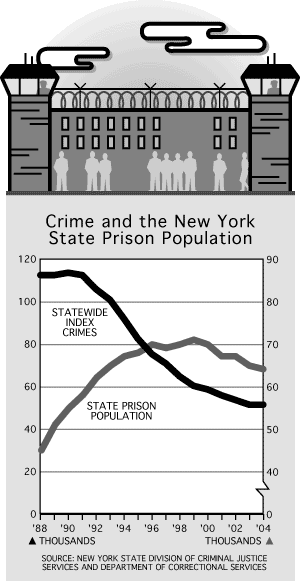
The results have been nothing less than spectacular: by one key measure, serious crime in the city has dropped 70 percent over the past 15 years.
But that success is also yielding another, less widely noticed, dividend: with felony arrests dropping as a result of the falling crime rate, New York’s once-swollen city jails and state prisons are becoming less crowded. This has begun to generate hundreds of millions of dollars in annual savings for state and city taxpayers.
As Chart 1 shows, the number of state prison inmates rose steeply in the late 1980s, with major “index” crimes in New York State peaking in 1990. The prison population continued to rise for a few years even after the drop in crime began to accelerate rapidly in 1993.
The trend lines started moving in the same direction in the late 1990s. In 1997, the prison population—roughly two-thirds from New York City—dipped slightly for the first time in 25 years. It rose again slightly in the two succeeding years, then began a five-year decline in 2000. The December 2004 population of just over 64,000 inmates was 10 percent below the 1999 peak of 71,431.
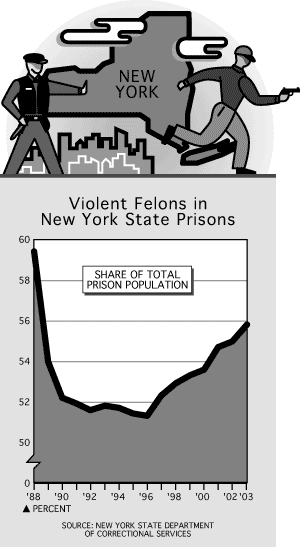
Nearly three-quarters of this decrease has consisted of nonviolent offenders, more than half of whom were serving drug-related sentences. Even before the recently enacted amendments to New York’s tough Rockefeller drug laws, the state was channeling more nonviolent offenders into treatment programs, work release, or “shock incarceration”—a form of behavior-modifying boot camp. As a result, a growing share of the remaining inmates are violent offenders, as Chart 2 shows. And in the wake of sentencing reforms enacted under Governor George Pataki, violent felons have been serving more time (26 months more, on average). Recidivism—the rate at which ex-cons return to prison within three years of their release—has decreased by about 16 percent during the 1990s.
Compared with the state prison population, New York City’s jail population peaked earlier, in 1992, and has dropped even further in recent years. By the end of 2004, the daily count of city inmates was below 14,000, about a third below its 1992 peak of 21,000, as Chart 3 shows. This was, in part, a ripple effect of the state’s prison expansion—for the construction of more cells upstate meant that fewer convicted “state-ready” felons had to be held at Rikers Island.
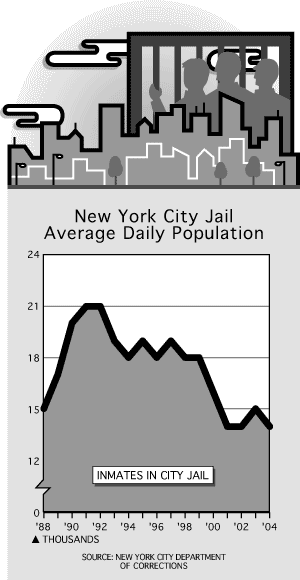
The decreasing jail population has enabled the city to close its detention facilities in Brooklyn, Queens, and the Bronx, to close some wings in other facilities, and to reduce the headcount of jail employees, saving at least $185 million a year in staff costs alone. The city corrections budget has declined nearly 8 percent in the last three years.
At the state level, the number of corrections officers has decreased by about 1,500 since 2000, generating a wage-and-benefit savings of roughly $120 million a year. So far, however, the state legislature has blocked greater operational savings by refusing to accept Pataki’s plans to close several prisons, which poorer upstate communities view as a jobs program. Given the state’s huge budget gap and the continuing decline in the prison population, the fight over excess prison space should intensify in the year ahead.
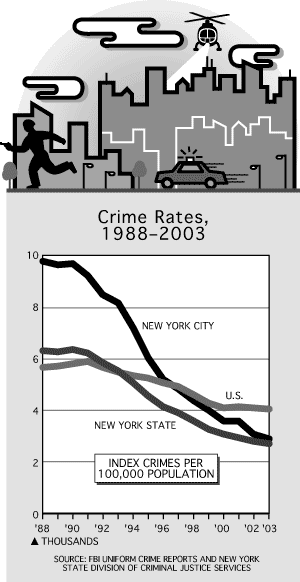
Nationally, the number of criminals behind bars continues to grow. Only a handful of states managed to reduce prison populations over the past few years—and New York is one of only two to report fewer inmates in 2003 than in 1995, according to federal data. While the size and average age of a state’s young male “cohort” plays an important role here, Gotham’s exceptionally large reduction in crime has surely influenced the downward trend. Near the height of the crack epidemic in 1988, New York City’s total crime rate was 73 percent above the national rate. By 2003, it was 28 percent below average. The plunge in city crime also pulled the statewide crime rate below the national average, as Chart 4 shows.
In 2003, New York continued to reduce its crime rate at more than five times the national pace. Thanks largely to its very low rate of “property” crimes (burglaries, larcenies, and car thefts), New York City’s overall crime rate is much lower than that of other major cities, as Chart 5 shows. However, among the ten largest cities, violent crime in New York is still higher than in San Diego, Phoenix, and San Antonio.
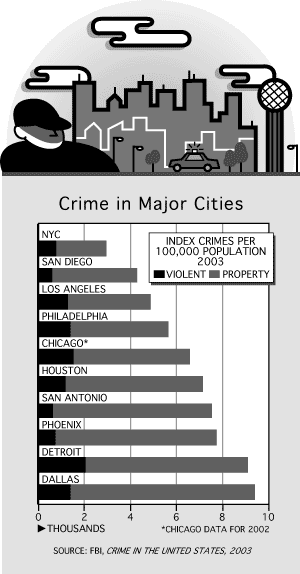
For years, the Left has warned that tougher sentencing would create a syndrome of “mass incarceration” and the creation of a “prison-industrial complex.” But as the New York experience shows, the crackdown has worked on more than one level. Good policing and tough sentencing have pushed New York to a tipping point, deterring some potential malefactors from crime. Now, if crime goes down and stays down, the prison population should keep dropping as well.





